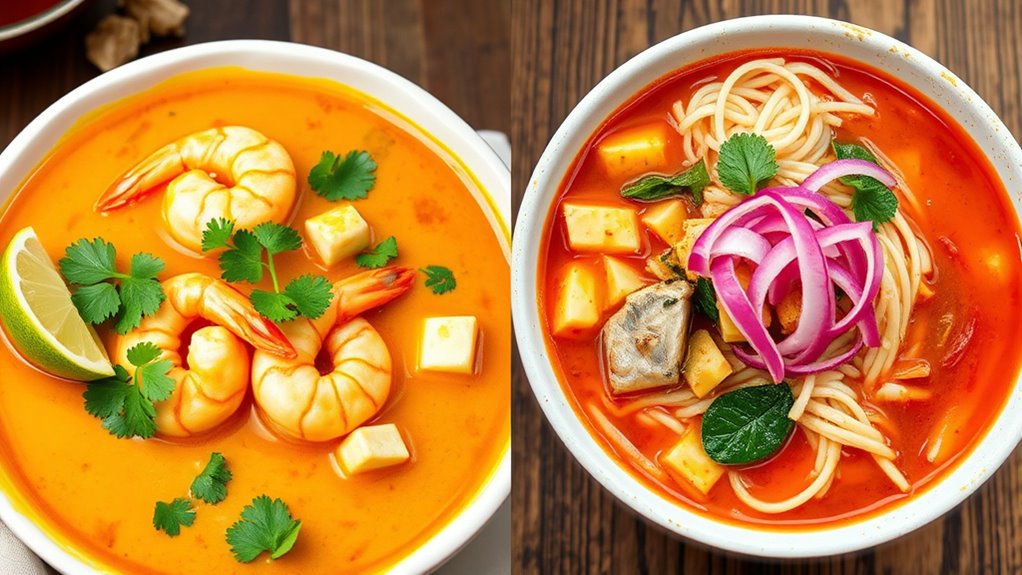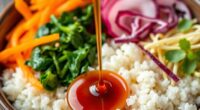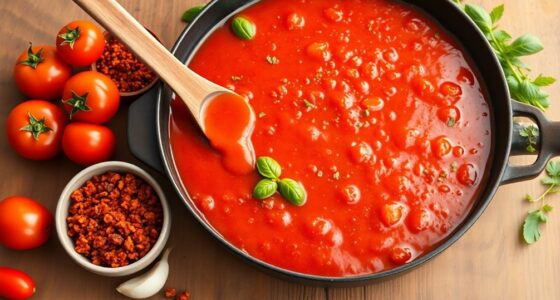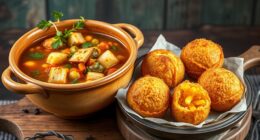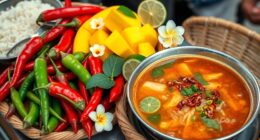Malaysian laksa comes in two main styles: curry laksa and asam laksa. Curry laksa offers a rich, creamy, and spicy flavor from coconut milk and aromatic spices, while asam laksa delivers a tangy, zesty taste using tamarind and fish broth. If you prefer warm comfort or bold spice, curry laksa suits you better. For a sour, invigorating kick, opt for asam laksa. To discover the unique regional twists and flavor profiles, keep exploring further.
Key Takeaways
- Curry laksa features a rich, coconut milk-based broth with aromatic spices, while asam laksa has a tangy, tamarind-based, fish broth.
- Curry laksa offers a creamy, spicy, and slightly sweet flavor profile; asam laksa is known for its sharp, sour, and invigorating taste.
- Noodles used in curry laksa are typically rice vermicelli or thick wheat strands; asam laksa often uses rice vermicelli with a more tangy broth.
- Curry laksa tends to be more filling and comforting; asam laksa is lighter, offering a bright, zesty, and refreshing experience.
- The choice between styles depends on flavor preference: creamy and spicy versus tangy and sour.
Origins and Cultural Significance of Curry and Asam Laksa
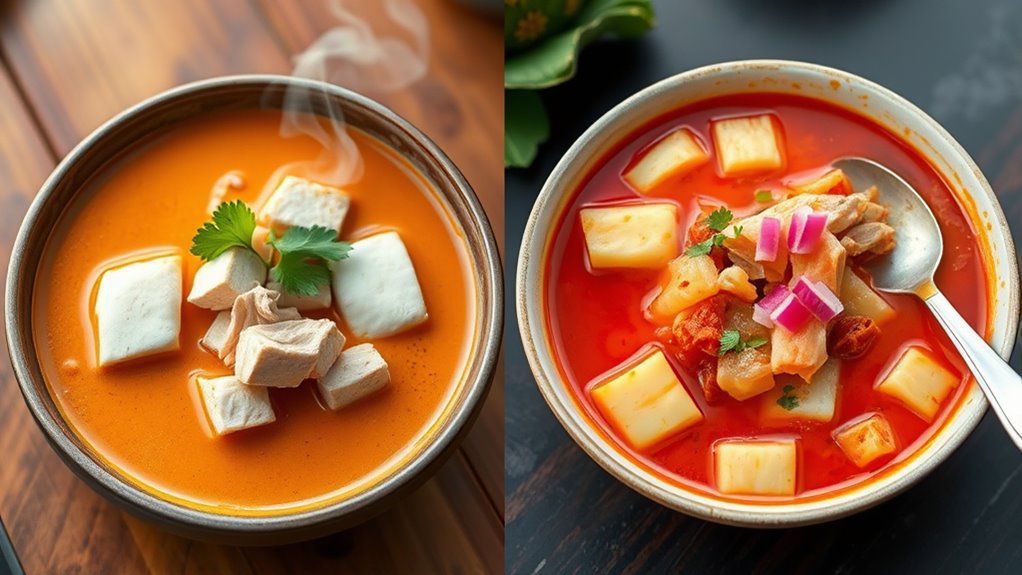
Curry Laksa and Asam Laksa are two iconic Malaysian dishes that reflect the country’s rich culinary heritage. You’ll find both dishes deeply rooted in Malaysia’s multicultural history, blending influences from Chinese, Malay, and Indian cuisines. Curry Laksa, with its creamy, spicy coconut milk broth, is popular in urban areas and symbolizes Malaysia’s Indian and Chinese connections. Asam Laksa, on the other hand, features a tangy, tamarind-based fish broth, highlighting the importance of local ingredients and Malay flavors. These dishes aren’t just about taste; they carry cultural significance, representing regional identities and traditions. For many Malaysians, enjoying laksa is a way to celebrate their diverse heritage, making it more than just a meal—it’s a cultural expression.
Key Ingredients and Base Broths
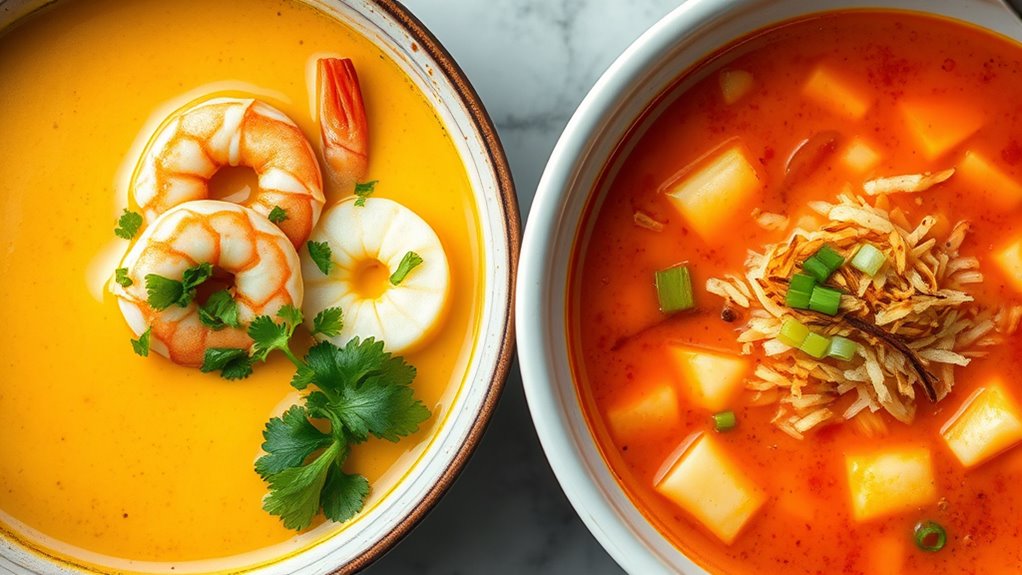
You’ll notice that the broth is the heart of Malaysian laksa, setting the flavor foundation. Curry laksa features a rich, spicy coconut milk base, while asam laksa has a tangy, tamarind-infused broth. Understanding these key ingredients helps you appreciate the distinct tastes each variety offers. Additionally, the base broths can be customized with various herbs and spices to elevate the overall flavor profile. Both types of laksa benefit from traditional cooking techniques, which enhance their authentic flavors and aromas.
Curry Laksa Broth
The rich, fragrant broth that defines curry laksa is built from a blend of aromatic spices, coconut milk, and flavorful base ingredients. You’ll notice a vibrant yellow hue from turmeric, complemented by spices like coriander, cumin, and lemongrass. Coconut milk adds creaminess and depth, balancing the heat and spices. A good curry laksa broth also includes prawn or chicken stock, enhancing umami flavor. The broth simmers to develop a layered taste that’s both spicy and rich. Proper shifting techniques while preparing or serving can help maintain the optimal temperature and consistency of the broth. Incorporating authentic ingredients can elevate the depth of flavor further.
Asam Laksa Base
What gives asam laksa its distinctive tangy and savory flavor is its vibrant, sour broth made from a blend of tamarind, fish stock, and aromatic herbs. Tamarind provides the signature sourness, balancing the richness of the fish stock. The fish stock, often made from mackerel or sardines, adds depth and umami. Aromatic herbs like lemongrass, torch ginger, and galangal infuse the broth with fresh, fragrant notes. Additionally, ingredients like dried chili, garlic, and shallots contribute to its complex flavor profile. You typically simmer these ingredients together until the broth develops a bright, tangy, and savory taste. This base forms the foundation of asam laksa, giving it its unique, bold character that sets it apart from other laksa styles. Color accuracy in the broth can also influence the visual appeal of the dish, making it more appetizing. Moreover, maintaining the right broth consistency is essential for achieving the authentic taste and texture of asam laksa. To enhance the authenticity, chefs often pay close attention to traditional preparation methods to ensure the flavors meld perfectly. Proper ingredient proportions are crucial for balancing the flavors and achieving the desired taste profile. Additionally, understanding the regional variations can help cooks tailor the broth to different preferences.
Flavor Profiles and Taste Characteristics
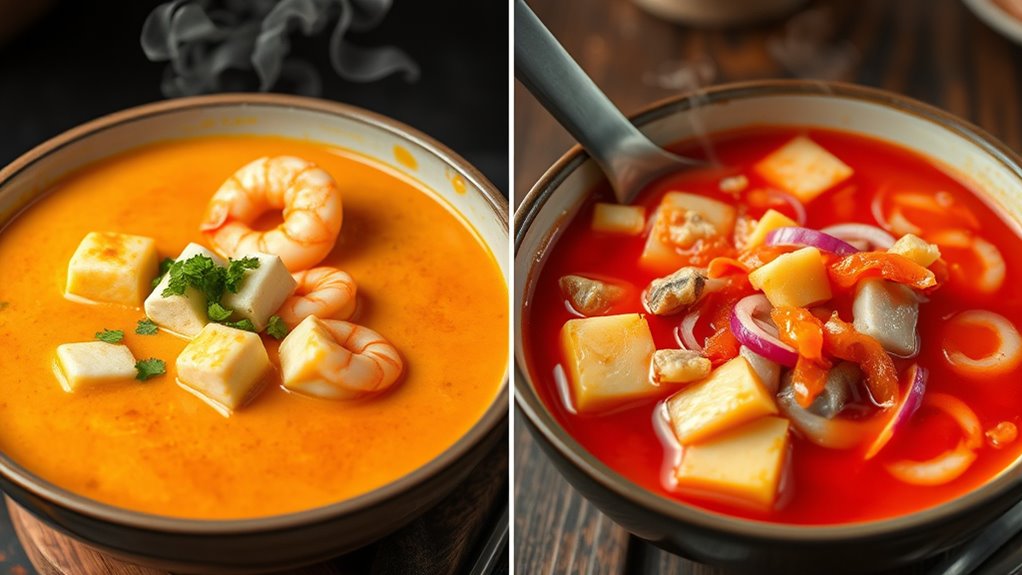
Malaysian laksa boasts a vibrant and complex flavor profile that balances richness, spiciness, and tanginess. In the Curry style, you’ll notice a warm, aromatic depth from turmeric, lemongrass, and coconut milk, creating a creamy, savory experience with subtle sweetness. The addition of specialized spray tips can enhance the consistency and texture of the curry, ensuring an evenly coated noodle bowl. The Asam style, meanwhile, delivers a sharp tang from tamarind and a bold, spicy kick from chilies and spices, resulting in a bright, invigorating taste. Both styles highlight layered flavors—herbs like mint or Vietnamese coriander add freshness—yet they differ in intensity. Curry laksa feels comforting and mellow, while Asam laksa excites your palate with its lively acidity. To maximize your culinary experience, understanding how Resources and Tools can enhance recipe and flavor analysis is beneficial. Additionally, exploring cultural influences can deepen your appreciation for the diversity of Malaysian cuisine. Regardless of the style, you’ll find each offers a distinctive, memorable taste that captures Malaysia’s diverse culinary spirit.
Typical Noodle Types and Accompaniments
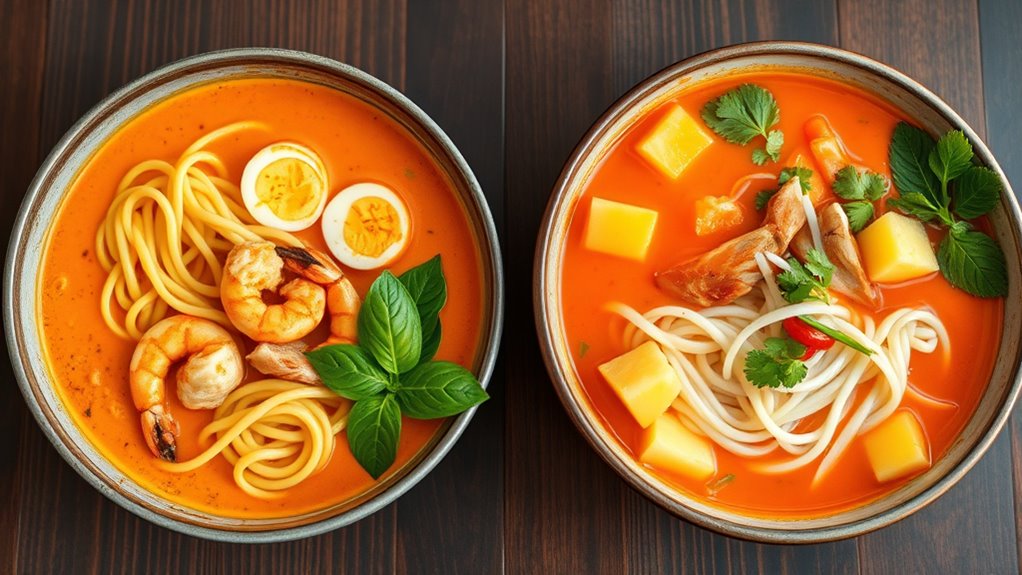
When you enjoy Malaysian laksa, you’ll notice a variety of noodles, like rice vermicelli and thick wheat-based strands, each adding a different texture. Common accompaniments include boiled eggs, fresh herbs, and lime wedges, which enhance the flavors. You can also customize your bowl with various garnishes and serving styles to suit your taste.
Noodle Varieties and Shapes
The noodles in Malaysian laksa come in various shapes and types, each contributing a unique texture and flavor to the dish. You might notice different styles depending on the region or recipe. For example:
- Thick rice noodles, which provide a chewy bite and hold rich broths well.
- Fine rice vermicelli, offering a lighter, more delicate texture.
- Laksa noodles, a wider, flat rice noodle specific to the dish.
- Egg noodles, occasionally used for added richness.
These varieties help balance the spicy, savory broth and complement the toppings. Choosing the right noodle type can elevate your laksa experience, adding the perfect mouthfeel and absorbing flavors differently. Each shape plays an essential role in defining the dish’s overall character.
Common Accompaniments and Sides
A variety of accompaniments and sides enhance the flavors of laksa, complementing its rich broth and noodles. Common toppings include boiled eggs, slices of fish or chicken, and fresh herbs like cilantro and Vietnamese mint, which add freshness and aroma. Crispy fried shallots or garlic bring a savory crunch, while lime wedges allow you to add a zesty kick. Some prefer a dollop of sambal or chili paste for heat. Bean sprouts and cucumber slices provide cool, crunchy contrasts to the hot broth. You might also see sliced tofu or seafood such as prawns and squid, which enrich the dish’s texture. To ensure the best eating experience, consider the flushing mechanism of your utensils to prevent any mess or inconvenience when enjoying spicy dishes. Additionally, understanding the eye patch benefits can help you care for your delicate skin after indulging in spicy foods. Incorporating performance upgrades like fresh herbs and crunchy toppings can elevate your laksa experience by adding layers of flavor and texture. Maintaining proper tuning of your utensils and ensuring they are clean can also enhance your overall dining pleasure. Being mindful of essential oils for toothache relief can be helpful if you experience any mouth discomfort from spicy ingredients, ensuring a comfortable meal. These sides allow you to customize your laksa experience, balancing spice, freshness, and crunch with every spoonful.
Serving Styles and Garnishes
Serving styles of Malaysian laksa vary widely, reflecting regional preferences and personal tastes. You might find it served with different noodles, each offering a unique texture and flavor. Here are some common options:
- Rice vermicelli – light and delicate, perfect for a quick, flavorful bite.
- Thick rice noodles – chewy and filling, ideal for richer curries.
- Laksa noodles – a special type of egg noodle that absorbs flavors well.
- Rice cakes – often added for extra texture and contrast.
Garnishes also vary, including boiled eggs, bean sprouts, fresh herbs, and lime wedges. Some serve laksa with a dollop of sambal or a sprinkle of fried shallots. These elements enhance the dish’s depth, making each bowl customizable to your taste preferences.
Regional Variations Across Malaysia
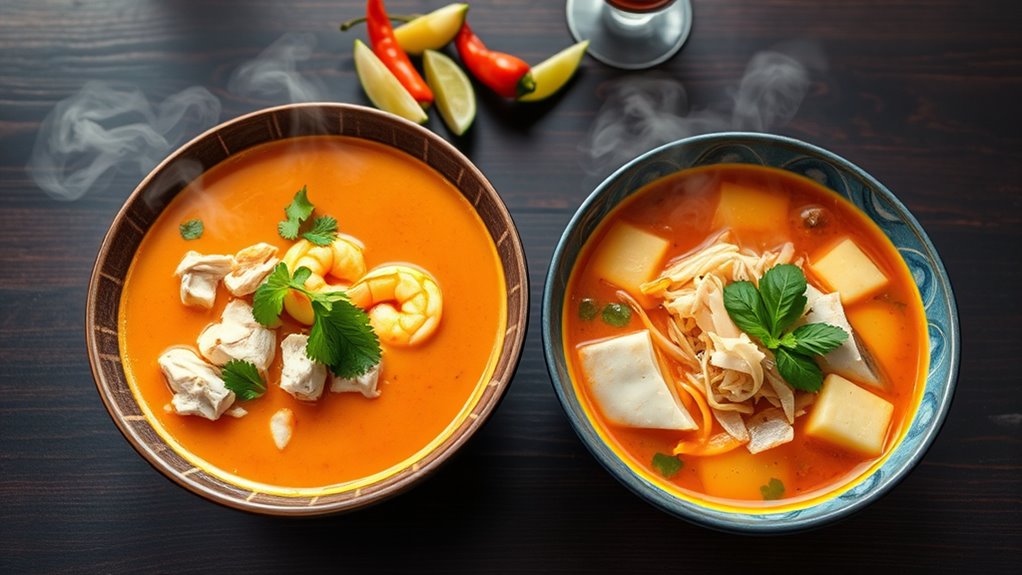
While Malaysian laksa shares core ingredients and flavors, you’ll notice significant regional differences that reflect local tastes and ingredients. In Penang, for example, Laksa Assam is famous for its tangy, spicy, and sour broth made with tamarind, fish, and herbs. In contrast, Laksa Lemak from the Kuala Lumpur area features a rich, coconut milk-based curry with a more mellow, creamy flavor. Sarawak’s Laksa Sarawak combines a fermented prawn paste with a slightly sweet, savory broth, often served with shredded chicken and vegetables. Each region adapts the dish to local ingredients, creating unique flavor profiles. These variations highlight Malaysia’s diverse culinary landscape, allowing you to experience different tastes and textures in each regional style. Additionally, regional water parks showcase similar diversity in attractions and themes, offering a variety of experiences to suit all preferences. Incorporating regional ingredients into recipes is a common practice in Malaysian cuisine, further enriching these local adaptations. Recognizing these regional culinary differences enhances appreciation for Malaysia’s rich food heritage.
Popular Toppings and Garnishes
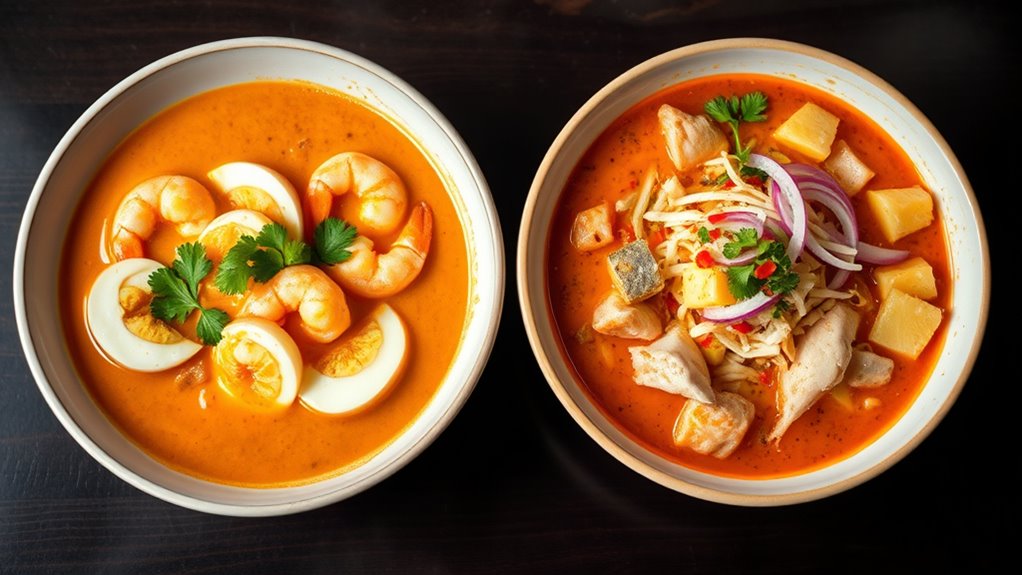
To enhance the rich flavors of Malaysian laksa, many toppings and garnishes are added just before serving, allowing you to customize each bowl to your taste. These toppings add texture, aroma, and visual appeal. First, fresh herbs like cilantro or Vietnamese coriander bring a burst of freshness. Second, boiled or fried egg halves provide creamy richness. Third, a squeeze of lime or lemon enhances the tangy notes, especially in Asam laksa. Fourth, sliced chili peppers or chili paste add heat and depth. Other common garnishes include bean sprouts for crunch, fish flakes for umami, and fried shallots for sweetness. Including antioxidant-rich berries can also contribute additional health benefits and vibrant color. Incorporating a variety of traditional ingredients allows you to explore different flavor profiles and elevate your laksa experience. Additionally, adjusting the tire pressure on gravel bikes based on terrain can improve comfort and traction, much like how balancing toppings enhances the laksa flavor. Properly managing the battery options can ensure consistent performance when preparing these flavorful bowls. These toppings allow you to tailor your laksa experience, balancing flavors and textures to suit your preferences perfectly.
Cooking Techniques and Preparation Methods
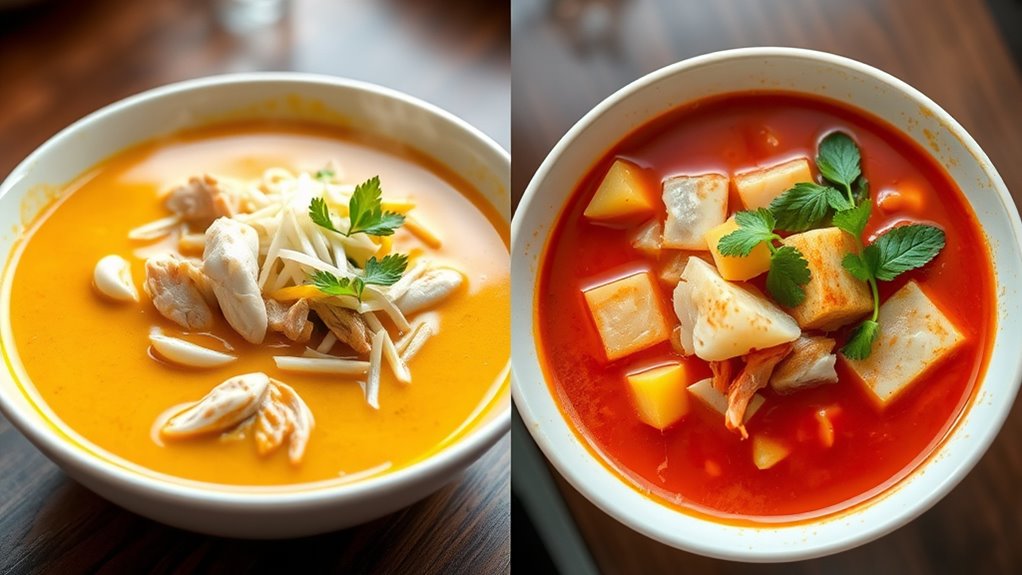
Mastering the cooking techniques for Malaysian laksa begins with preparing a flavorful broth, which is the foundation of the dish. For curry laksa, you’ll simmer spices like turmeric, cumin, and coriander with coconut milk to create a rich, aromatic base. Asam laksa requires simmering fish bones, tamarind paste, and lemongrass to develop its tangy, savory flavor. You’ll need to carefully control the heat to extract maximum flavor without burning ingredients. To preserve the freshness and potency of your ingredients, consider storing spices properly before cooking. Next, cook your noodles separately—rice vermicelli or rice noodles—until tender. Meanwhile, prepare your proteins and vegetables, adding to the broth just before serving. Stir everything gently to combine, ensuring the flavors meld. Precise timing and proper heat management are key to achieving a well-balanced, authentic laksa.
Pairing Suggestions and Complementary Dishes
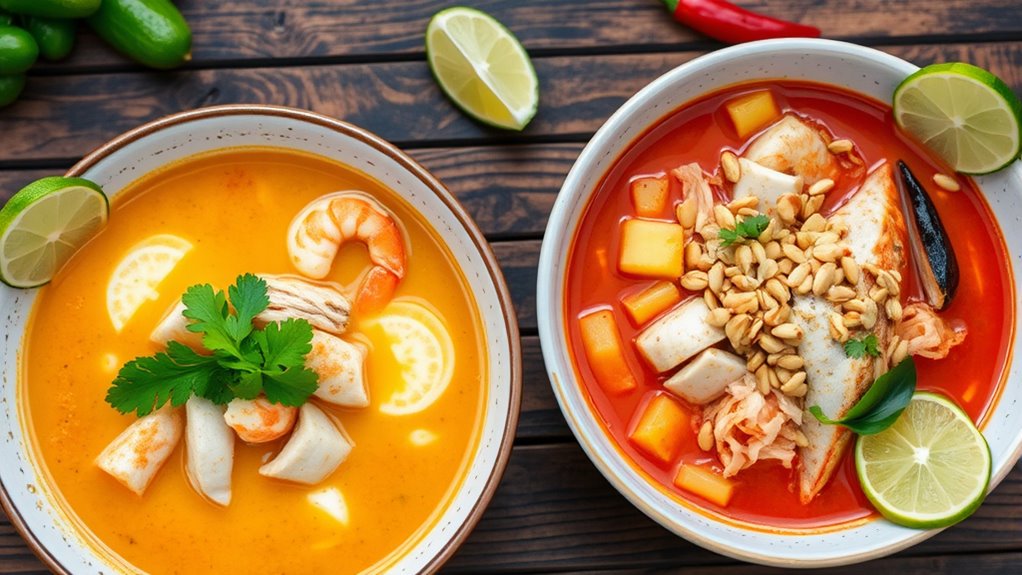
Pairing Malaysian laksa with the right side dishes and beverages can elevate your dining experience. To enhance each bowl, consider these options:
- Prawn Crackers – Add crunch and a salty contrast to the spicy broth.
- Pickled Vegetables – Offer a tangy, invigorating balance to rich flavors.
- Fresh Herbs – Garnish with cilantro or mint for added aroma and brightness.
- Iced Tea or Lime Juice – Refresh your palate and cut through the heat.
These pairings complement the complex flavors of both Curry and Asam laksa, balancing spice, acidity, and texture. They turn a simple bowl into a well-rounded meal, making each bite more satisfying. Choose your favorites to create a personalized laksa experience that’s both flavorful and harmonious.
Nutritional Aspects and Dietary Considerations
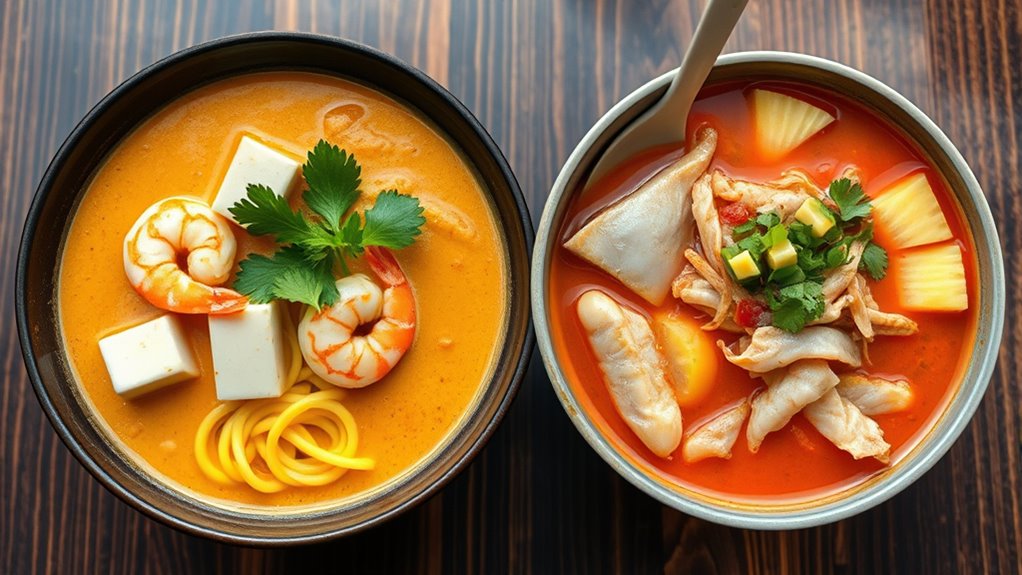
Malaysian laksa offers a flavorful combination of ingredients, but it’s important to contemplate its nutritional content and how it fits into your dietary needs. While rich in protein from seafood or chicken, it can also be high in sodium and saturated fats, especially with creamy coconut milk or fried toppings. To help you visualize, here’s a quick overview:
| Nutrient | Benefits | Considerations |
|---|---|---|
| Protein | Builds muscle, keeps you full | Watch portion sizes |
| Carbohydrates | Provides energy | Limit refined carbs |
| Fats | Supports cell function | Prefer healthy fats |
| Sodium | Regulates fluids | Can be excessive in some recipes |
| Calories | Fuel your day | Be mindful of calorie density |
How to Choose Between Curry and Asam Laksa
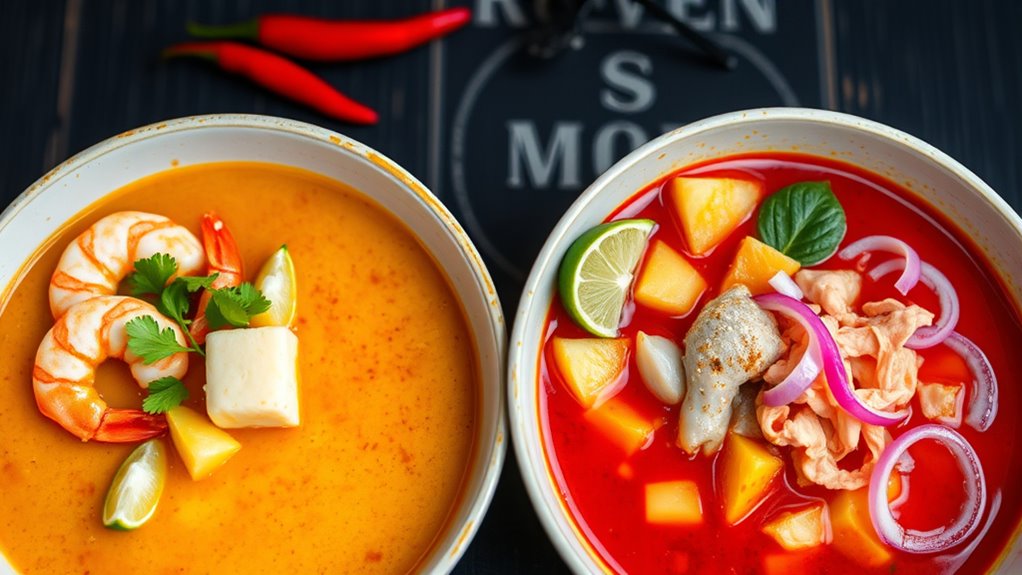
When choosing between curry laksa and asam laksa, consider your flavor preferences and dietary goals. Curry laksa offers a rich, creamy, and spicy broth, perfect if you enjoy bold flavors and a comforting meal. Asam laksa provides a tangy, sour, and slightly spicy broth, ideal if you prefer a invigorating, lighter taste. To decide, think about:
- Do you want a creamy, coconut-based soup (Curry Laksa)?
- Are you craving the sharp, tangy flavor of tamarind (Asam Laksa)?
- Do you prefer a richer, more filling dish (Curry Laksa)?
- Or do you prefer something lighter and zesty (Asam Laksa)?
Your choice depends on your flavor mood and dietary needs, making each laksa uniquely satisfying.
Frequently Asked Questions
What Are the Health Benefits of Curry Versus Asam Laksa?
When comparing the health benefits of curry and asam laksa, you’ll find that curry often provides anti-inflammatory properties thanks to turmeric and spices, which can boost your immunity. Asam laksa, with its tangy tamarind and fish broth, offers omega-3 fatty acids and vitamin C. Both dishes can be nutritious, but curry might support your overall health more due to its medicinal spices, while asam laksa adds hydration and antioxidants.
How Do Curry and Asam Laksa Compare in Spiciness Levels?
You’ll find that curry laksa tends to be spicier than asam laksa, thanks to its generous use of chili paste and spices. Asam laksa has a tangy, sour flavor with a milder heat level, often balanced by tamarind and other ingredients. If you prefer a fiery kick, curry laksa is your go-to, but if you want something milder and tangy, asam laksa offers a more subdued spice experience.
Can Curry and Asam Laksa Be Made Vegetarian or Vegan?
You can definitely make both curry and asam laksa vegetarian or vegan. For curry laksa, swap out meat or seafood with tofu, vegetables, or plant-based proteins, and use vegetable broth. For asam laksa, replace fish stock with mushroom or miso broth, and add more vegetables or tofu. With these substitutions, you preserve the flavorful essence while keeping the dish plant-based and suitable for vegans.
Which Laksa Style Is More Popular Among Tourists?
Did you know that curry laksa is more popular among tourists? You’ll notice more visitors craving its rich, spicy coconut broth. Its vibrant flavors and creamy texture appeal to many first-time Malaysian food explorers. As you travel, you’ll see curry laksa on menus worldwide, often outnumbering asam laksa options. So, if you’re looking for a dish that’s both comforting and adventurous, curry laksa is likely your best choice.
Are There Any Traditional Festivals Celebrating Curry or Asam Laksa?
You might be curious if any traditional festivals celebrate curry or asam laksa. While specific festivals solely dedicated to these dishes are rare, food festivals across Malaysia showcase them prominently, highlighting regional flavors. During events like Malaysia Food Festival, you’ll find stalls serving authentic curry and asam laksa, allowing you to experience their cultural significance firsthand. These festivals celebrate Malaysia’s rich culinary heritage, making them perfect for food lovers like you to explore.
Conclusion
So, next time you craving Malaysian flavors, will you plunge into the spicy, creamy depths of curry laksa or the tangy, invigorating burst of asam laksa? Both promise a unique journey for your taste buds, but only you can decide which story to savor first. Are you ready to explore these iconic bowls and uncover their secrets? The choice is yours—your perfect laksa adventure awaits just around the corner.
